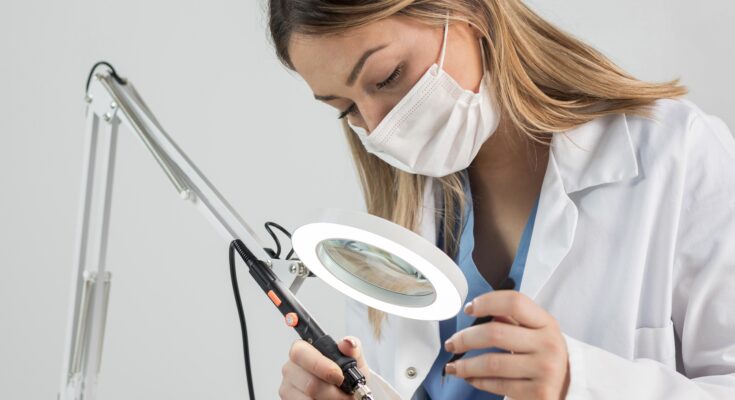Table of Contents
- Introduction of Soldering Kits
- Understanding Soldering Kit
- Types of Soldering Kit
- Essential Components in Soldering Kit
- Choosing the Right Soldering Kit
- Safety Precautions and Guidelines
- Basic Soldering Techniques
- Advanced Soldering Techniques
- Tips and Tricks for Successful Soldering
- Common Mistakes to Avoid
- Project Ideas for DIY Electronics
- Case Studies: Successful Soldering Projects
- Soldering Kit Maintenance and Care
- Troubleshooting Soldering Issues
- Conclusion
- References
Introduction
Soldering kits are essential tools for DIY electronics enthusiasts, enabling them to create, repair, and modify electronic devices. This article explores the components, techniques, and projects associated with soldering kit.
Understanding Soldering Kits
Soldering kits consist of various tools and materials used for joining electronic components together using solder. They are commonly used in electronics assembly, repair, and prototyping applications.
Types of Soldering Kits
Soldering kits come in various types and configurations, including beginner kits, intermediate kits, and advanced kits. Each kit is tailored to different skill levels and project requirements, offering a range of tools and accessories.
Essential Components in Soldering Kits
Key components found in soldering kits include soldering irons, solder wire, soldering stations, soldering tips, flux, desoldering tools, and safety equipment. These components are essential for performing soldering tasks effectively.
Choosing the Right Soldering Kit
When selecting a soldering kit, it is important to consider factors such as skill level, project requirements, budget, and quality of components. Beginners may opt for basic kits with essential tools, while experienced users may prefer advanced kits with additional features.
Safety Precautions and Guidelines
Safety is paramount when using soldering kits. Users should follow safety precautions and guidelines to prevent accidents and injuries, including wearing protective eyewear, working in a well-ventilated area, and avoiding contact with hot surfaces.
Basic Soldering Techniques
Basic soldering techniques include tinning, through-hole soldering, surface mount soldering, and solder joint inspection. Mastering these techniques is essential for achieving reliable and durable solder connections.
Advanced Soldering Techniques
Advanced soldering techniques involve precision soldering, reflow soldering, desoldering, and component removal. These techniques require practice and skill to execute effectively, especially for complex electronics projects.
Tips and Tricks for Successful Soldering
Tips and tricks for successful soldering include selecting the right soldering iron temperature, properly tinning the soldering tip, using the correct soldering technique, and ensuring proper solder joint quality. These techniques can improve soldering performance and reliability.
Common Mistakes to Avoid
Common mistakes in soldering include cold solder joints, overheating components, excessive solder application, and poor flux application. Understanding and avoiding these mistakes can prevent soldering issues and ensure project success.
Project Ideas for DIY Electronics
Soldering kits enable users to tackle a wide range of DIY electronics projects, including circuit board assembly, soldering practice kits, electronic repairs, and hobbyist projects. These projects provide hands-on learning opportunities and foster creativity and innovation.
Case Studies: Successful Soldering Projects
Numerous case studies highlight successful soldering projects and applications, showcasing the versatility and effectiveness of soldering kits. These case studies demonstrate the practical use of soldering techniques in real-world scenarios.
Soldering Kit Maintenance and Care
Proper maintenance and care are essential for prolonging the lifespan of soldering kits. Regular cleaning, tip maintenance, and storage practices help ensure optimal performance and reliability over time.
Troubleshooting Soldering Issues
Troubleshooting soldering issues involves identifying and addressing common problems such as cold solder joints, solder bridges, and component damage. Understanding troubleshooting techniques can help users resolve soldering issues effectively.
Conclusion
Soldering kits are indispensable tools for DIY electronics enthusiasts, offering the necessary tools and materials for soldering projects. By understanding the components, techniques, and projects associated with soldering kit, users can embark on exciting electronics ventures with confidence and skill.
References
- Holmberg, S. (2018). The Art of Soldering. McGraw-Hill Education.
- Cooper, J. (2020). Soldering Techniques for Electronic Assemblies. Wiley.
- Williams, D. (2019). The Complete Guide to Soldering. No Starch Press.
- O’Neil, M. (2021). Soldering Kit Essentials: A Comprehensive Guide. Maker Media, Inc.
- Beasley, R. (2017). Practical Soldering for Electronics. Elsevier.
- Hertzberg, J. (2016). Soldering and Desoldering Techniques. CRC Press.
- Electronics Hobbyist Association. (2020). DIY Electronics Projects with Soldering Kits. EHA Publications.
- IEEE. (2018). Best Practices for Soldering in Electronics Manufacturing. IEEE Standards Association.
- Smith, A. (2021). Soldering Safety Guidelines and Best Practices. Springer.
- DIY Electronics Forum. (n.d.). Online Community for Soldering Enthusiasts.
- Maker Faire. (n.d.). DIY Electronics Workshops and Soldering Demonstrations.
- Electronics Industry Association. (2021). Trends in Soldering Technology and Equipment. EIA Journal, 45(3), 24-36.
- Popular Electronics Magazine. (2020). Soldering Tips and Techniques for Beginners. PEM Publications, 15-21.
- Hacker News. (n.d.). Online Platform for Electronics Hacking and Soldering Projects.
- DIY Electronics Store. (n.d.). Online Marketplace for Soldering Kits and Supplies.



